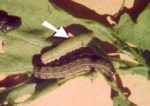Armyworm
Spodoptera litura ()
Lepidoptera: Noctuidae
Spodoptera litura () is also known under the following synonyms: Prodenia litura , Mamestra albisparsa , Prodenia ciligera , Prodenia declinata , Noctua elata , Prodenia evanescens , and Prodenia glaucistriga . Common names are Armyworm, Taro caterpillar, Tobacco budworm, and Rice cutworm.
S. litura, is one of the most important insect pests of agricultural crops in the Asian tropics. This species is widely distributed throughout tropical and temperate Asia, Australasia and the Pacific Islands.
Why is S. litura difficult to control?
- it is a polyphagus insect
Host plants and damage

S. litura is totally polyphagous and host plants from 40 families, containing more than 130 species are reported. Among the main crop species attacked by S. litura in the tropics are: Brassica rapa (pak-choi), Zea mays (maize), Lycopersicon esculentum (tomato), Oryza sativa (rice), Ipomoea batatas (sweet potato), Glycine max (soyabean), Vigna unguiculata (cowpea)
Plant growth stages affected
Flowering, fruiting, and vegetative growing stages.
Affected plant parts
On most crops, damage arises from extensive feeding by larvae on leaves, but larvae may also attack fruits/pods.
Symptoms
Leave damage by larval feeding can lead to complete stripping of the plants.
Morphology & biology

S. litura eggs are laid in clusters of several hundreds, usually on leave surfaces. Fecundity varies from 2000-3000 eggs.
Larvae are hairless and variable in colour (young larvae are light green; later instars are dark green to brown on the dorsal side with light ventral sides).
Sides of the body have dark and light longitudinal bands. The dorsal side has two dark semilunar spots positioned laterally on each segment. Though the markings are variable, a bright-yellow stripe along the length of the dorsal surface is characteristic of S. litura larvae. There are six instars.

Pupation takes place in the soil. The pupal period lasts about 7-10 days.
The moth has a grey-brown body and is 15-20 mm long with a wingspan 30-38 mm. The forewings are grey to reddish-brown with a strongly variegated pattern and paler lines along the veins. The hindwings are greyish-white with grey margins, often with dark veins in S. litura.
Monitoring
Young larvae often feed together on leaf surfaces, but larger caterpillars tend to feed alone. Search the entire plant to locate them. Look carefully on the upper and lower surfaces of leaves.
The identification of a male sex pheromone allows effective monitoring of this species in traps.
Pest management
Developments in pheromone technology have made it possible to monitor S. litura in the field and to improve timing of plant protection measures.
Biological control
S. litura is known to be attacked by many natural enemies at various life stages. Altogether more than 130 species of natural enemies have been reported from different parts of the world.
So far four fungi have been reported to infect S. litura and cause physiological disorders in larval growth and development: Aspergillus flavus, Beauveria bassiana, Nomuraea rileyi, and Metarhizium anisopliae.
Chemical Control
S. litura has developed resistance to many commercially available pesticides. In addition to synthetic insecticides, Nucleopolyhedrosis virus (NPV) and Bacillus thuringiensis (Bt) have proved to be effective as microbial insecticides.
Recommendations for better management:
- use pheromone traps to predict egg laying and early infestation
- possible mechanical collection of egg masses
- possible use of NPV